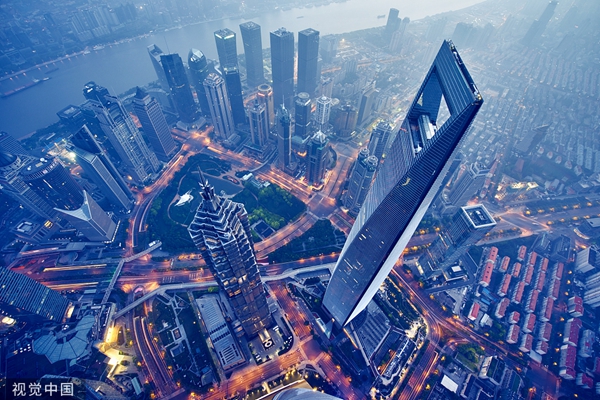Shanghai sees increasing number of high-level scientists

An aerial view of high-rise buildings in Shanghai. [Photo/VCG]
Shanghai is among the top five cities in the world experiencing a large increase of the number of high-level scientists in the last decade, and the city's status as an international talent hub is prominent, according to the 2022 "Ideal City" Global High-level Scientist Analysis Report, which was released at the 2022 Pujiang Innovation Forum.
The number of high-level scientists in Shanghai increased by more than 8,000 in 2021 compared to that in 2012, which is a staggering 3.8 times more than the number in 2012, according to the report.
The Shanghai Institute for Science of Science and Springer Nature launched the report's survey, conducted statistical analysis and correlation research on high-level scientists and their academic achievements emerging in 20 major cities known for their scientific and technological innovation, in order to study the talent agglomeration pattern, hub effect, and development trend of central cities in the global scientific and technological innovation talent network.
Report highlights Shanghai's status as an international talent hub
Statistical analysis results showed that in 2021, the number of high-level scientists in Beijing, Shanghai, New York, London, and Boston ranked among the top five among the world's 20 major cities, with Hong Kong and Shenzhen ranking 10th and 14th, respectively. In recent years, Beijing and Shanghai have initially formed global highlands where high-level scientists are concentrated.
In addition, Beijing, Boston, New York, London and Moscow ranked in the top five with the highest number of the top 2,000 scientists among the 20 cities, with Shanghai, Hong Kong and Shenzhen ranking 13th, 14th and 17th, respectively.
The annual statistical analysis of high-level scientists distributed in the 20 cities from 2012 to 2021 shows that the top five cities with the largest increase in the number of high-level scientists in the past 10 years are Beijing, Shanghai, London, New York and Shenzhen.
In 2021, the total number of high-level scientists in Beijing, Shanghai, Hong Kong and Shenzhen was about 3.5 times more than that in 2012. Shanghai's status as a talent hub is prominent, and its attraction to overseas talents is outstanding. From 2012 to 2021, the number of high-level scientists in Shanghai increased from 2,940 to 11,215, an increase of 281.46 percent.
Among the 20 cities, Beijing, Shanghai, New York, Shenzhen, and Boston are among the top five cities that had the most significant talent inflows from 2012 to 2021. Beijing and Shanghai rank high among the top 20 cities in terms of the total number, inflow and outflow of high-level scientists, reflecting a remarkable talent hub effect.
The balance of discipline development has been significantly improved
According to the comprehensive statistical analysis results of high-level papers written by scientists in the 20 cities, which were included in the 2018-2020 "Nature Index", the top five cities in terms of scientific research output among the 20 cities are Beijing, New York, Boston, San Francisco and Shanghai. Hong Kong and Shenzhen ranked 13th and 15th, respectively.
The top 10 cities in terms of scientific research output include four East Asian cities (Beijing, Shanghai, Tokyo, and Seoul), four American cities (New York, Boston, San Francisco, and Los Angeles), and two Western European cities (Paris and London), indicating that global professionals specializing in scientific and technological innovation tend to gather in these three regions.
According to a detailed statistical analysis of the output of scientists in the 20 cities, which is based on the subject categories of the journals included in the "Nature Index", Chinese cities have significant advantages in talent agglomeration and achievement output in chemistry, engineering technology, physics and interdisciplinary fields. European and American cities represented by New York and London have more prominent advantages in the fields of life sciences and medicine. Moscow, Paris, and Bangalore show special comparative advantages in the field of physics. Seoul and Singapore show special comparative advantages in the field of engineering technology.
In the 2019 "Ideal City" Global Science and Technology Innovation Sourcing City Analysis Report, which is based on statistical data from 2017, Beijing's three fields — chemistry, physics and engineering technology, and Shanghai's two fields — chemistry and physics, accounted for more than 10 percent of the city's scientific research output. The 2018-2020 statistics in the 2022 report showed that the figure reached five and four for Beijing and Shanghai, respectively, indicating that in recent years, Beijing and Shanghai have significantly improved the balance of discipline development.

 Print
Print Mail
Mail




